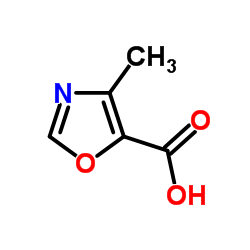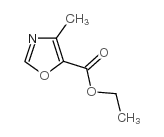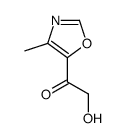62348-24-7
| 中文名 | 4-甲基恶唑-5-羰酰氯 |
|---|---|
| 英文名 | 4-methyl-1,3-oxazole-5-carbonyl chloride |
| 中文别名 | 4-甲基-5-羰基氯异唑 |
| 英文别名 |
4-methyl oxazole-5-carbonyl chloride
MFCD06200856 4-Methyl-5-oxazolecarbonyl chloride 4-methyl-5-oxazolecarboxylic acid 4-methyl-oxazol-5-carbonyl chloride |
| 密度 | 1.345g/cm3 |
|---|---|
| 沸点 | 80ºC |
| 分子式 | C5H4ClNO2 |
| 分子量 | 145.54400 |
| 闪点 | 72.6ºC |
| 精确质量 | 144.99300 |
| PSA | 43.10000 |
| LogP | 1.36200 |
| 折射率 | 1.498 |
| 分子结构 | 1、 摩尔折射率:31.71 2、 摩尔体积(cm3/mol):108.1 3、 等张比容(90.2K):276.8 4、 表面张力(dyne/cm):42.9 5、 极化率(10-24cm3):12.57 |
| 计算化学 | 1.疏水参数计算参考值(XlogP):1.6 2.氢键供体数量:0 3.氢键受体数量:3 4.可旋转化学键数量:1 5.互变异构体数量:无 6.拓扑分子极性表面积43.1 7.重原子数量:9 8.表面电荷:0 9.复杂度:128 10.同位素原子数量:0 11.确定原子立构中心数量:0 12.不确定原子立构中心数量:0 13.确定化学键立构中心数量:0 14.不确定化学键立构中心数量:0 15.共价键单元数量:1 |
Synonym:None Known Section 2 - COMPOSITION, INFORMATION ON INGREDIENTS
Risk Phrases: 14 20/21/22 29 35 Section 3 - HAZARDS IDENTIFICATION EMERGENCY OVERVIEW
Reacts violently with water. Harmful by inhalation, in contact with skin and if swallowed. Contact with water liberates toxic gas. Causes severe burns.Water-reactive. Potential Health Effects Eye: Causes severe eye burns. Skin: Causes severe burns. Ingestion: Causes severe digestive tract burns. Inhalation: Causes chemical burns to the respiratory tract. Chronic: Chronic exposure may cause effects similar to those of acute exposure. Section 4 - FIRST AID MEASURES Eyes: In case of contact, immediately flush eyes with plenty of water for at least 15 minutes. Get medical aid immediately. Skin: If water-reactive products are embedded in the skin, no water should be applied. The embedded products should be covered with a light oil. In case of contact, immediately flush skin with plenty of water for at least 15 minutes while removing contaminated clothing and shoes. Get medical aid immediately. Wash clothing before reuse. Ingestion: If swallowed, do NOT induce vomiting. Get medical aid immediately. If victim is fully conscious, give a cupful of water. Never give anything by mouth to an unconscious person. Inhalation: Get medical aid immediately. Remove from exposure and move to fresh air immediately. If breathing is difficult, give oxygen. Do NOT use mouth-to-mouth resuscitation. If breathing has ceased apply artificial respiration using oxygen and a suitable mechanical device such as a bag and a mask. Notes to Physician: Section 5 - FIRE FIGHTING MEASURES General Information: As in any fire, wear a self-contained breathing apparatus in pressure-demand, MSHA/NIOSH (approved or equivalent), and full protective gear. During a fire, irritating and highly toxic gases may be generated by thermal decomposition or combustion. Water Reactive. Material will react with water and may release a flammable and/or toxic gas. Extinguishing Media: DO NOT USE WATER! Do NOT get water inside containers. Contact professional fire-fighters immediately. Use dry chemical, dry sand, or carbon dioxide. Section 6 - ACCIDENTAL RELEASE MEASURES General Information: Use proper personal protective equipment as indicated in Section 8. Spills/Leaks: Absorb spill with inert material (e.g. vermiculite, sand or earth), then place in suitable container. Avoid runoff into storm sewers and ditches which lead to waterways. Clean up spills immediately, observing precautions in the Protective Equipment section. Provide ventilation. Do not expose spill to water. Section 7 - HANDLING and STORAGE Handling: Do not allow water to get into the container because of violent reaction. Do not breathe dust, vapor, mist, or gas. Do not get in eyes, on skin, or on clothing. Keep container tightly closed. Do not ingest or inhale. Use only in a chemical fume hood. Discard contaminated shoes. Keep from contact with moist air and steam. Storage: Keep container closed when not in use. Keep away from water. Store under an inert atmosphere. Section 8 - EXPOSURE CONTROLS, PERSONAL PROTECTION Engineering Controls: Use explosion-proof ventilation equipment. Facilities storing or utilizing this material should be equipped with an eyewash facility and a safety shower. Exposure Limits CAS# 62348-24-7: Personal Protective Equipment Eyes: Wear appropriate protective eyeglasses or chemical safety goggles as described by OSHA's eye and face protection regulations in 29 CFR 1910.133 or European Standard EN166. Skin: Wear appropriate protective gloves to prevent skin exposure. Clothing: Wear appropriate protective clothing to prevent skin exposure. Respirators: Follow the OSHA respirator regulations found in 29 CFR 1910.134 or European Standard EN 149. Use a NIOSH/MSHA or European Standard EN 149 approved respirator if exposure limits are exceeded or if irritation or other symptoms are experienced. Section 9 - PHYSICAL AND CHEMICAL PROPERTIES Physical State: Liquid Color: colorless Odor: Not available. pH: Not available. Vapor Pressure: Not available. Viscosity: Not available. Boiling Point: 80 deg C @ 10-12mmHg Freezing/Melting Point: Not available. Autoignition Temperature: Not available. Flash Point: Not available. Explosion Limits, lower: Not available. Explosion Limits, upper: Not available. Decomposition Temperature: Solubility in water: Specific Gravity/Density: Molecular Formula: C5H4ClNO2 Molecular Weight: 145.54 Section 10 - STABILITY AND REACTIVITY Chemical Stability: Combines vigorously or explosively with water. Reacts with water to form hydrogen chloride, a toxic and corrosive gas. Conditions to Avoid: Exposure to moist air or water. Incompatibilities with Other Materials: Oxidizing agents, water, bases. Hazardous Decomposition Products: Hydrogen chloride, carbon monoxide, oxides of nitrogen, carbon dioxide, chlorine. Hazardous Polymerization: Has not been reported Section 11 - TOXICOLOGICAL INFORMATION RTECS#: CAS# 62348-24-7 unlisted. LD50/LC50: Not available. Carcinogenicity: 4-Methyloxazole-5-carbonyl chloride - Not listed by ACGIH, IARC, or NTP. Section 12 - ECOLOGICAL INFORMATION Ecotoxicity: Fish: Pseudomonas putida: Section 13 - DISPOSAL CONSIDERATIONS Dispose of in a manner consistent with federal, state, and local regulations. Section 14 - TRANSPORT INFORMATION IATA Shipping Name: CORROSIVE LIQUID, WATER-REACTIVE, N.O.S. Hazard Class: 8 UN Number: 3094 Packing Group: II IMO Shipping Name: CORROSIVE LIQUID, WATER-REACTIVE, N.O.S. Hazard Class: 8 UN Number: 3094 Packing Group: II RID/ADR Shipping Name: CORROSIVE LIQUID, WATER-REACTIVE, N.O.S. Hazard Class: 8 UN Number: 3094 Packing group: II Section 15 - REGULATORY INFORMATION European/International Regulations European Labeling in Accordance with EC Directives Hazard Symbols: C Risk Phrases: R 14 Reacts violently with water. R 20/21/22 Harmful by inhalation, in contact with skin and if swallowed. R 29 Contact with water liberates toxic gas. R 35 Causes severe burns. Safety Phrases: S 23 Do not inhale gas/fumes/vapour/spray. S 24/25 Avoid contact with skin and eyes. S 26 In case of contact with eyes, rinse immediately with plenty of water and seek medical advice. S 36/37/39 Wear suitable protective clothing, gloves and eye/face protection. S 45 In case of accident or if you feel unwell, seek medical advice immediately (show the label where possible). WGK (Water Danger/Protection) CAS# 62348-24-7: No information available. Canada None of the chemicals in this product are listed on the DSL/NDSL list. CAS# 62348-24-7 is not listed on Canada's Ingredient Disclosure List. US FEDERAL TSCA CAS# 62348-24-7 is not listed on the TSCA inventory. It is for research and development use only. SECTION 16 - ADDITIONAL INFORMATION N/A |
| 危害码 (欧洲) | C |
|---|---|
| 海关编码 | 2934999090 |
|
~94% 
62348-24-7 |
| 文献:Jacobi, Peter A. Patent: US2009/143346 A1, 2009 ; Location in patent: Page/Page column 8 ; |
|
~% 
62348-24-7 |
| 文献:Organic Letters, , vol. 8, # 18 p. 4125 - 4128 |
| 上游产品 2 | |
|---|---|
| 下游产品 3 | |
| 海关编码 | 2934999090 |
|---|---|
| 中文概述 | 2934999090. 其他杂环化合物. 增值税率:17.0%. 退税率:13.0%. 监管条件:无. 最惠国关税:6.5%. 普通关税:20.0% |
| 申报要素 | 品名, 成分含量, 用途 |
| Summary | 2934999090. other heterocyclic compounds. VAT:17.0%. Tax rebate rate:13.0%. . MFN tariff:6.5%. General tariff:20.0% |





